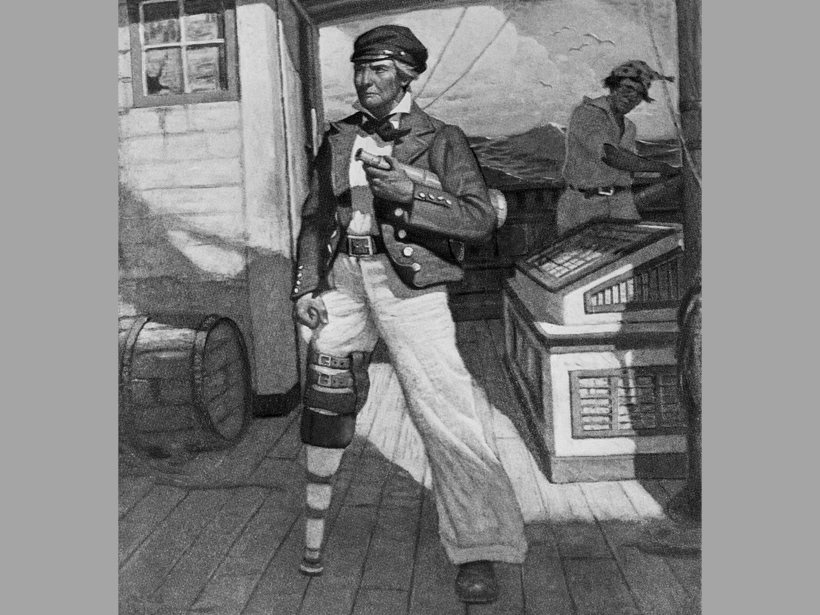In the 124th chapter of Herman Melville’s Moby Dick, “The Needle,” Ahab and his crew discover that their whaleship’s compass needles have reversed as a consequence of the previous day’s electrical storm. This has caused the Pequod to sail in the exact opposite direction from its intended course, dismaying the superstitious sailors. To restore their tattered confidence, Ahab resorts to a bit of geomagnetic magic.
Proclaiming that he is “lord over the level loadstone yet,” Ahab orders up “a lance without the pole; a top-maul, and the smallest of the sail-maker’s needles.” (Lodestones were magnetic rocks used as early compasses. A top maul is a large, heavy hammer used in shipbuilding.)
With these tools, Ahab gets to work.
With a blow from the top-maul Ahab knocked off the steel head of the lance, and then handing to the mate the long iron rod remaining, bade him hold it upright, without its touching the deck. Then, with the maul, after repeatedly smiting the upper end of this iron rod, he placed the blunted needle endwise on the top of it, and less strongly hammered that, several times, the mate still holding the rod as before. Then going through some small strange motions with it—whether indispensable to the magnetizing of the steel, or merely intended to augment the awe of the crew, is uncertain—he called for linen thread; and moving to the binnacle, slipped out the two reversed needles there, and horizontally suspended the sail-needle by its middle, over one of the compass cards. At first, the steel went round and round, quivering and vibrating at either end; but at last it settled to its place, when Ahab, who had been intently watching for this result, stepped frankly back from the binnacle, and pointing his stretched arm towards it, exclaimed,—“Look ye, for yourselves, if Ahab be not the lord of the level loadstone! The sun is East, and that compass swears it!”
The sailors are cowed by this stunning display of Ahab’s knowledge and power:
One after another they peered in, for nothing but their own eyes could persuade such ignorance as theirs, and one after another they slunk away.
And the episode, for Ahab, is his grandest moment:
In his fiery eyes of scorn and triumph, you then saw Ahab in all his fatal pride.
Ahab seeks to “induce magnetization” in the needle through shock remanent magnetization.
But was Ahab indeed “lord of the level loadstone”?
By hammering the lance and then the carpenter’s needle, Ahab seeks to induce magnetization in the needle through shock remanent magnetization, reorganizing its magnetic domains and providing it with an accurate reading of north and south.
To do so, he should have aligned the lance with the Earth’s magnetic field. In 1851, the date of the publication of Moby Dick, the magnetic North Pole would have been located in Canada’s far northern Boothia Peninsula.
At this point in Moby Dick, however, the Pequod is moving into the Pacific well southeast of Japan, where the dip of the field would be about 41°. With lance and needle being held upright, this would have thwarted Ahab’s magnetization attempt.
In addition, Ahab makes a fatal error: He treats his mariner’s compass as if it were a landlubber’s compass. A Brunton is an example of a landlubber’s compass: The needle swings freely and independently above the compass rose printed on the compass base.

A mariner’s compass is quite different: The pairs of needles, one of each pair on each side of the pivot, are affixed to the base of the compass rose, which swings as a unit upon the pivot. This “compass card” maintains its orientation with the geomagnetic field as the ship itself changes direction. The helmsman reads the ship’s direction from the position of the compass card in relation to a “lubber line” marking the bow-to-stern axis of the ship.
With Ahab having removed their needles, the Pequod’s compass cards would point in some unknown, arbitrary direction. A magnetized needle suspended by a thread may have pointed north, but the compass card it would have been held above would not reliably indicate that. Further, any change in the ship’s direction would not result in a change in the orientation of the Pequod’s compass card.
Despite the failure of Ahab’s “magic,” Melville says it awed the Pequod’s crew, as does Moby Dick itself on this 200th anniversary of its author’s birth.
—Dan Dorritie ([email protected]).
For an extended version of this article, please contact the author.
Citation:
Dorritie, D. (2019), Was Ahab truly “lord of the level loadstone”?, Eos, 100, https://doi.org/10.1029/2019EO132017. Published on 04 September 2019.
Text © 2019. The authors. CC BY-NC-ND 3.0
Except where otherwise noted, images are subject to copyright. Any reuse without express permission from the copyright owner is prohibited.

